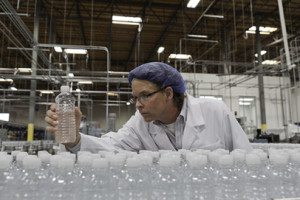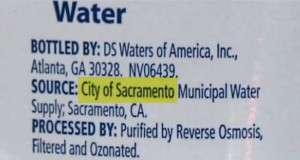Bottled Water-Is It Really Safe for Your Family?
Bottled Water-Is It Really Safe for Your Family?
 Water is everywhere, right? It’s a natural resource. As a smart prepper you know that water is one of those basic necessities you need to have stockpiled when SHTF. The most convenient way to stockpile water for a lot of preppers, especially those who urban dwellers, planning to bug in, is to stockpile lots of bottled water. In fact, you may have already made the switch from municipal tap water to bottled water. But is bottled water actually safe for your family?
Water is everywhere, right? It’s a natural resource. As a smart prepper you know that water is one of those basic necessities you need to have stockpiled when SHTF. The most convenient way to stockpile water for a lot of preppers, especially those who urban dwellers, planning to bug in, is to stockpile lots of bottled water. In fact, you may have already made the switch from municipal tap water to bottled water. But is bottled water actually safe for your family?
Sources of Bottled Water:
Regardless of the form in which it comes to you, all water originates in two places, ground water, such as aquifers or springs, or surface water such as lakes and streams. In fact, if you check your state water rights, you will find laws may be different for ground water than for surface water.
The EPA reports that over 90% of public water systems originate from ground water. And yet, over 60% of all people use water systems that rely on surface water. This is because in the densely populated large cities, public water systems tend to rely on surface water from lakes and streams, whereas in the more rural and less densely populated areas, ground water, aquifers or springs, is more likely to feed water systems.
So, no matter what water you use, it comes from two sources originally, either the ground or the surface. Tap water which is monitored by the EPA (Environmental Protection Agency). Regardless of where it originates, bottled water is regulated by the FDA (Food and Drug Administration). This matters because EPA regulations are actually stricter than FDA guidelines as far as treatment and filtering procedures.
This means that your tap water could actually be safer for your family than the bottled water you are buying.
How to Tell Where My Bottled Water Comes From
Check with your State Department of Health to see if they maintain a list of certified bottling facilities. Some states, like New York, do keep a list on their website that is easily accessible. You can check brand name against the list of certified facilities. New York State also requires water bottling facilities to include their certification number right on the label. If the bottler is listed on the label, you can contact them and ask what their water source is.
 Trying to identify whether that bottled water you are paying for is really just tap water, isn’t always easy. Check the label or even the bottle cap for the words from “a community water system” or “a municipal source”. If you see either of these, you are buying water that originally was “tap water”. If there is nothing on the label or cap, call the bottler directly or contact the health department in the state where the water was bottled for more information.
Trying to identify whether that bottled water you are paying for is really just tap water, isn’t always easy. Check the label or even the bottle cap for the words from “a community water system” or “a municipal source”. If you see either of these, you are buying water that originally was “tap water”. If there is nothing on the label or cap, call the bottler directly or contact the health department in the state where the water was bottled for more information.
Potential Water Contaminants
Bottled water is generally considered relatively safe for you to drink, especially if you can determine that it was bottled by a state certified bottling facility. Because contamination is always possible, it is safer to boil water before drinking, especially if used for children, the elderly, or those with immune system deficiencies.
State inspected bottling facilities and their sources are checked regularly. If a problem is discovered during inspection, a recall will be issued. But it is possible a water source could be contaminated for several months prior to the next inspection. A Natural Resources Defense Council (NRDC) review over four years, found that most bottles tested were relatively contaminant free and high quality. Just over 20% of brands tested, did contain, in at least one bottle, chemical contaminants higher than state limits.
You are probably most familiar with contaminants such as phthalates, which have been said to leach from plastic bottles and containers, over time, into the water inside. It is worthwhile to note that there are currently no legal limits on phthalates in bottled water. Tap water, regulated by the EPA, does have a legal limit on phthalates. In that way, tap water is actually safer.
 Parasites can find their way into water sources. One of the more common ones is Cryptosporidium or Crypto. This parasite is microscopic, it lives in the intestine of is host, and is shed in bowel movements. It can cause cryptosporidiosis, a diarrheal disease. There are a multitude of Crypto species, many of which infect animals. Humans are also susceptible to some of these. It can be found in food, soil, or contaminated surfaces, but recreational (pools and lakes) water and drinking water is one of the most common ways Crypto is spread.
Parasites can find their way into water sources. One of the more common ones is Cryptosporidium or Crypto. This parasite is microscopic, it lives in the intestine of is host, and is shed in bowel movements. It can cause cryptosporidiosis, a diarrheal disease. There are a multitude of Crypto species, many of which infect animals. Humans are also susceptible to some of these. It can be found in food, soil, or contaminated surfaces, but recreational (pools and lakes) water and drinking water is one of the most common ways Crypto is spread.
Crypto symptoms begin within ten days of infection. The most common symptom is watery diarrhea but individuals may experience stomach pain or cramps, nausea or vomiting, fever, dehydration, and weight loss. Symptoms typically last a few days to two weeks in individuals with normal immune systems but can reoccur sporadically over thirty days. Medications may be necessary for those with weakened immune systems but most people recover without medical treatment.
To prevent reduce likelihood of Crypto infection, water should be heated at a full boil for a minimum of 1 minute at low altitude and for 3 full minutes at altitudes higher than 6,562 feet. Crypto can be removed using reverse osmosis filtering, an NSF International Standard certified filter for “cyst reduction” or “cyst removal”, or an “absolute one micron” filter.
Filtering doesn’t eliminate all bacteria and viruses. Filtered water must be boiled or distilled for safety. EPA guidelines are designed to filter Cryptosporidium from public water systems so again, tap water is less likely to be contaminated.
So, is bottled water safe for your family? All you can do is to know as much as possible about where your bottled water originated and how it was treated during the bottling process. Make a decision about whether it’s safe to drink. If necessary, use filtering and boiling or distillation combined to increase safety.
Bottled Water Bottled Water-Is It Really Safe for Your Family Contaminants Parasites safe Sources Water

